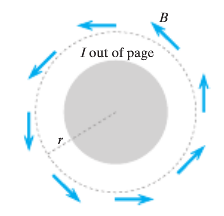Magnetic Field of a Long Thick Wire Using Ampere's Law
The Main Idea
This section explains how to find the magnetic field near a long thick wire using Ampere's Law. Finding the magnetic field using Ampere's Law is very simple compared to finding it using the Biot-Savart law.
Formula for Ampere's Law
How to Find Magnetic Field of A Long Thick Wire
To find the magnetic field [math]\displaystyle{ B }[/math] at a distance [math]\displaystyle{ r }[/math] from the center of the long wire apply Ampere's Law. By the symmetry of the wire [math]\displaystyle{ B }[/math] will always be constant and tangential to the circular path at every point around the wire.
The path integral [math]\displaystyle{ {{\oint}d\vec{l}} }[/math] in this situation is equal to the circumference of the circular path around the wire. This is equal to [math]\displaystyle{ 2πr }[/math].
Using the formula above and plugging in [math]\displaystyle{ {d\vec{l}} }[/math] we have: [math]\displaystyle{ {B(2πr) = μ_0I} }[/math]. To solve for [math]\displaystyle{ B }[/math] divide both sides by [math]\displaystyle{ 2πr }[/math].
This results in the equation: [math]\displaystyle{ {B = \frac{μ_0I}{2πr}} }[/math] which is equal to [math]\displaystyle{ {\frac{μ_02I}{4πr}} }[/math]. This is the equation for the magnetic field of a long thick wire that is found using the Biot-Savart law.
Examples
Simple
What is the magnetic field at a point 0.03 m away from a wire that has a current of 7 amperes?
Solution: [math]\displaystyle{ I=7 }[/math] and [math]\displaystyle{ r=0.03 }[/math]. So inserting this into the formula gives [math]\displaystyle{ {B = \frac{μ_0(7)}{2π(0.03)}} }[/math]. This results in 4.67e-5 T
Middling
A long straight wire suspended in the air carries a conventional current of 7.4 amperes in the -x direction as shown (the wire runs along the x-axis). At a particular instant an electron at location < 0, -0.004, 0 > m has velocity < -3.5 e5, -4.2 e5, 0 > m/s. What is the magnetic field due to the wire at the location of the electron?
Solution: Using the same formula as above and also implementing the right hand rule this equates to < 0, 0, 3.7e-4 > T.
Hard
Using the same values as in the middling problem calculate the magnetic force on the electron due to the wire.
Solution: The formula for magnetic force is [math]\displaystyle{ qv×B }[/math]. So by using the value for B computed above and calculating the cross product between B and qv we find that this equals < 2.49e-17, -2.07e-17, 0 > N. Don't forget that because this is the force on an electron q is negative.
See also
See the page on Ampere's Law for a more in depth look at the law itself: Ampere's Law
For more applications of Ampere's Law see: Magnetic Field of a Toroid Using Ampere's Law and Magnetic Field of Coaxial Cable Using Ampere's Law
Further reading
Matter and Interactions (4th ed., Vol. 2)
External links
http://hyperphysics.phy-astr.gsu.edu/hbase/magnetic/magcur.html
References
Chabay, Sherwood. (n.d.). Matter and Interactions (4th ed., Vol. 2). Raleigh, North Carolina: Wiley. page 887.

